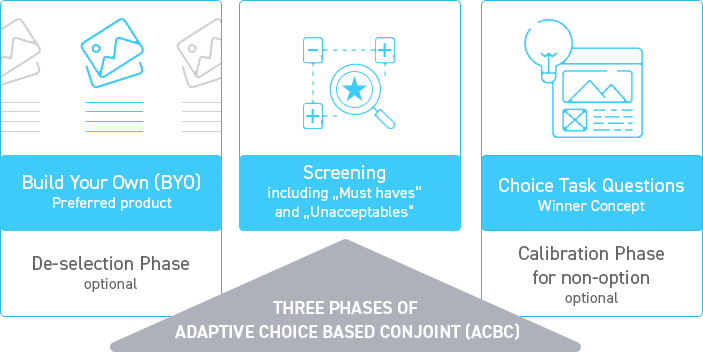Adaptive Choice Based Conjoint (ACBC)
ADAPTIVE CHOICE BASED CONJOINT FOR RELEVANT PRODUCT VARIANTS IN COMPLEX DECISION PROCESSES
The Adaptive Choice Based Conjoint method provides a better representation of the decision-making process of buyers in complex purchasing situations (e.g. B2B). This is because more attributes and more attribute levels can be included in the ACBC than in a classic conjoint analysis. And due to the varied and for the respondent relevant three phases of this conjoint procedure, the survey can take more time than a traditional Choice-Based Conjoint survey.
COMBINATION OF TWO CONJOINT METHODS
In Adaptive Choice Based Conjoint (ACBC), we combine the advantages of classic Adaptive Conjoint Analysis (ACA) and the Choice-Based Conjoint survey method. As a result, this Conjoint method responds to the respondents’ answers.
The Adaptive Choice-Based Conjoint data is collected in three phases. Its content depends on the information provided in the preceding questions::
- Phase 1: Build your own (BYO)
- Phase 2: Screening
- Phase 3: Choice Task Tournament

Adaptive Choice Based Conjoint
THE THREE PHASES OF ADAPTIVE CHOICE BASED CONJOINT
- Phase 1: Build your own (BYO)
Each respondent builds his or her preferred product on the basis of the pre-defined attributes and attribute levels. - Phase 2: Screening
The product built in the preceding section serves as the basis for the definition of further products, which differ at individual levels. The respondent indicates, for each of these products, whether it comes into consideration or not.
On the basis of these responses it is determined whether particular attributes are essential to the respondent, or are unacceptable. For these “must haves” or “unacceptables”, the respondent is again asked explicitly whether the attribute really must be present or may on no account be present. - Phase 3: Choice Task Tournament
The products found acceptable in the screening phase are then presented in groups, out of which the respondent selects the most preferred product in each group.
THE ADVANTAGES OF ADAPTIVE CHOICE-BASED CONJOINT
- The concepts shown are relevant for the respondent.
- The various phases make the interview more interesting for the respondent.
- The respondent has the chance to eliminate irrelevant features.



